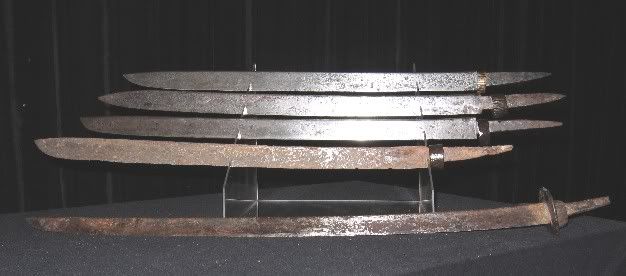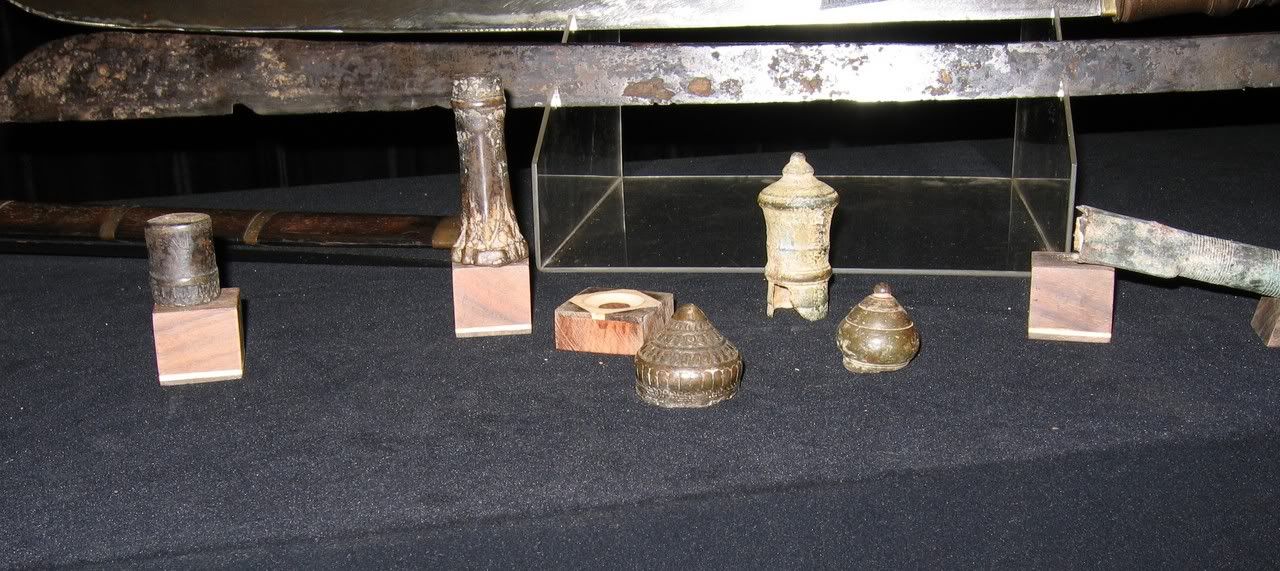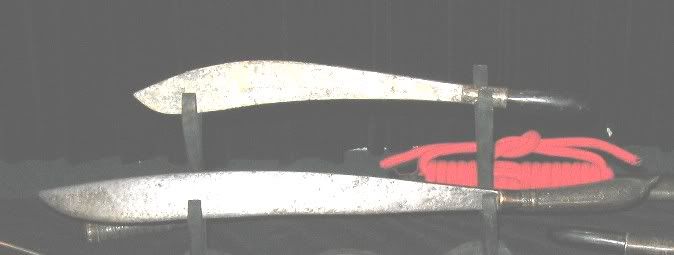
 |
|
|
#1 |
|
Member
Join Date: May 2006
Posts: 16
|
On Sunday 16 july 2006 we have small group of thai who interest in Weapons
MR.Parinya Sanyadet born in Ayutthaya prov. He found many weapons (and part) 16C - 19C from underground and in the River. Art on weapons and Technic to made and how to use diff. from Burmese and Cambodia Weapons Sword 18c  Knife 19c  Part of knife & Sword  Big Blades Knife 19c 
|
|
|

|
|
|
#2 |
|
Member
Join Date: Feb 2006
Location: 30 miles north of Bangkok, 20 miles south of Ayuthaya, Thailand
Posts: 224
|
The first pic shows the highlight of the meeting. They are example of swords found in Ayuthaya city core, especially in Wat KaiTia (a temple in Ayuthaya) and surrounding area. Tons of these blade recovered from river bed and sold as salvage steel during past 30+ years. We hypothesized that the blade 's a style of mid-Ayuthaya period. Some of them might be dated to earlier period since they come together with gold decorative which are associated with early Ayuthaya. We concluded that this is one of a major style (from many) blade, used in that period (C15?-C18). They share some common characteristics which are...
1. Clip point+False edge (60-90 degree edge angle), from the tip upto 1-3 inches. Looks very similar to Bowie knife. 2. Tips are not very pointy (wide tip angle), in the most case, tip's curvature are only cover the first few inches. 3. Blade chest/waist (aka, ratio of blade width at 1/4 and 3/4 from the tip) 's close to 1. In some case, the ratio is <1. Unlike the later Rattanakosin blades which has >1 ratio. 4. An important point, they almost always carry a little inner ferrule (1/8"-2/8" thick), called PaGan. This is an important device which are keeping their tang securely in place and also reducing hand shock (we concluded from reconstructed blades, with and without this ring). 5. Style of the spine 's what I call single taper, almost no taper. The spine 's almost in parallel upto the beginning of false edge. And in most case, the spine carry 2-3 little "V" upsetting, looks very similar to lotus petal decorative. Some of them come up with a little guard and longer blade but still carrying the typical features. Last edited by PUFF; 19th July 2006 at 01:11 PM. |
|
|

|
|
|
#3 |
|
Member
Join Date: Feb 2006
Location: 30 miles north of Bangkok, 20 miles south of Ayuthaya, Thailand
Posts: 224
|
This is an example of utility knife, found in Ayuthaya city and surrounding area. Please note that the clip point style is preserved. The round butt hilt 's typical design for commoner 's item. Unlike Burmese 's small sword, many Ayuthaya 's utility knives seems to have upward hilts.
 Even a bigger chopper which seems to be ancestors of moden "Meed Hneb". 
|
|
|

|
|
|
#4 |
|
Member
Join Date: Dec 2004
Location: Greenville, NC
Posts: 1,857
|
Fascinating pics. Thanks gentleman!!
The last pic of the choppers I find especially interesting because it changes a bit my perceptions of blade types from that area. These almost have an Indo Malay klewang or golok look about them. I am wondering if one culture may have influenced the other, and if so in which direction that influence flowed. |
|
|

|
|
|
#5 |
|
Member
Join Date: Dec 2004
Posts: 987
|
Yes, thank you both, and your fellow collectors at the meeting. This is like cool water to a man in the desert to me!
 If I understand #4 correctly, Ayutthaya daab have a more uniform width (meaning edge-to-spine) than Ratanakosin daab? Looking the other way, Ratanakosin daab bulge out more toward the tip? The PaGan is an interesting feature. Is it something that you can only see when the handle is removed? There is not one visible on my Ayutthaya daab (http://dharesearch.bowditch.us/0056.htm). |
|
|

|
|
|
#6 |
|
Member
Join Date: Jan 2006
Posts: 123
|
What great find! I'm always fascinated by Thai weapons and the origin about the style of technique in using them in war, which I heard is unbeatable (I don't if anyone would disagree, but I believe it)! Ayutthaya means unbeatable anyway, but it was sacked by the Burmese twice but only by internal bickering, corruption and collaberators. Well, I guess then it's not unbeatable! Ha! Thanks for sharing Kun Bancha!
|
|
|

|
|
|
#7 |
|
Member
Join Date: Jun 2006
Posts: 165
|
Wow. Thank you for posting these. Any pics of the little "V" marks?
|
|
|

|
|
|
#8 |
|
Member
Join Date: Feb 2006
Location: 30 miles north of Bangkok, 20 miles south of Ayuthaya, Thailand
Posts: 224
|
Mark, from the meeting, I learned that Ayuthaya 's a kind of culture soup. There are more than 20 ethnic groups in that little area. We estimated more than 100 Krabi-KraBong schools were co-exist. This kind of Dahb (according to its archaeological site, we named Wat KaiTia style blade) could be just one of many other major styles. Beside this one, especially in the late Ayuthaya, glass leaf, rice leaf, sheep foot, cut-off head and Japanese influenced styles were also popular. I cannot say that Ayuthaya blades have uniformly width. But I can say that this style has been popularly used, and, so far, the oldest one we have found for that local and period.
The PaGan is inner ferrule. So you cannot see it from outside, without removal of the handle. Even without little plate guard, most of the hilts are covered with resinous stuff. And in my recent case, the inner ferrule is made of wood !!! (which I hypothesized as a transition between metal PaGan and no PaGan) If excessive force were applied during outer ferrule removal, or the handle has too much weather damage, you might not be able to find the inner one. |
|
|

|
|
|
#9 |
|
Member
Join Date: May 2006
Posts: 16
|
One sword fom the river
 19C spear (King Barommakot Like Budda very much. Thai use lotus symbol in weapons) 
|
|
|

|
|
|
#10 |
|
Member
Join Date: Feb 2006
Location: 30 miles north of Bangkok, 20 miles south of Ayuthaya, Thailand
Posts: 224
|
Here 's the little "V" on the spine. IMO: this design is an integral lotus petal decorative.
These are pictures of a broken sword found in the area. Some blades have 2-3 "V" marks on their spine. Khun Bancha 's pictures show lotus style ferrules which were popular for some period. The lotus ferrules are usually associated with noble/royal sword, not for commoner 's weapon. |
|
|

|
 |
|
|